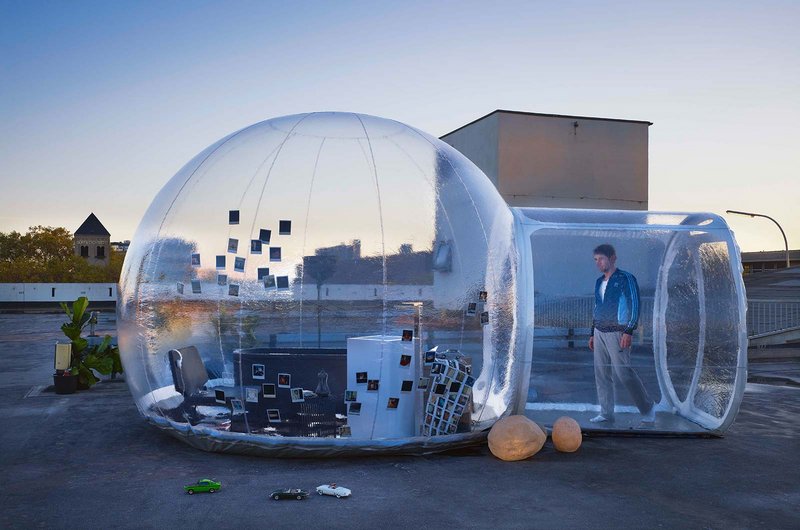
02_ Bathroom Bubble: Urban
Bathroom Bubble creates boundaries in an environment where the boundaries are be- coming increasingly blurred. Like an isolated bubble within a permeable living cocoon, the bathroom becomes a very private island – the perfect place to relax, think or be creative.
Bathroom Bubble – room to retreat
The modern bathroom is the embodiment of retreat into a world of one's own, far removed from everyday life. In future, as the core area of a private home that is increasingly becoming the focal point of life, the bathroom will gain even more significance – as an isolated bubble within a permeable living cocoon.
Our home is more than just a dwelling. For us, it is almost like the interface between the microcosm and the macrocosm, providing protection on the outside and a whole world of its own on the inside – with its own organisational forms and its own aesthetics, it is the expression of a world view, as much a stage as it is a nest, a carefully balanced blend of self-portrayal and private retreat. As a result, architects and planners must keep constant track of the factors that change our interior culture and thus also influence our expectations of how our own four walls should be designed. Besides demographic developments, one question that is set to become more important in future concerns precisely this equilibrium. For as a result of extreme individualisation and the fact that, in the age of the performance society and Facebook, privacy is becoming an increasingly scarce commodity, new anchor points are needed in order to preserve the delicate balance.
But which room actually creates the greatest amount of distance to the outside world? Where are the walls thick enough to block out the din of the world? What does it have to be like, this place where we can be alone with ourselves, where our voice echoes back to us – but where we can still get enough air to breathe and aren't shut off from nature? Or from the city that surrounds us? For at the end of the day, when we make our home the focal point of our life, it's not as if we want to cut ourselves off from our environment completely. Instead, our home serves as a filter that only allows what (and who) we want to surround ourselves with to permeate. We seek a space that conveys a sense of security without becoming a prison. A softly padded monastic cell with a view.
A welcome change to a culture of permanent representation
As a virtually timeless, intimate place, the bathroom provides a welcome change to a culture of permanent representation in which we are accustomed to constantly defining our image via our appearance, our work, our style and our consumption. Today, public perception of that image is also increasingly focusing on our choice of a home and how we design it. Besides shaping the opinion our friends have of us, our home also affects how we are seen by the wider circle of acquaintances and colleagues that we are increasingly admitting to our private world. This long-term development is being driven by several factors: the relocation of a large part of our social life to our homes, the increasingly blurred borders between our private and working lives and the spread of the home office. In future, furnishing the bathroom as a final place of retreat and designing it as a cosy space will thus become even more important to our personal wellbeing.
And yet it is not a question of opposites, of the contrast between areas of retreat and presentation. It has more to do with the idea of a space within a space, a capsule beneath the outer shell, as protected as the smallest figure in a set of nesting dolls. Accordingly, the design of the bathroom can certainly be based on the same representation requirements as the rest of the home. It isn't just that, even here, the user applies the highest standards of comfort and aesthetics in order to enjoy the time he spends here himself – he also wants his beautiful bathroom to be a demonstration of sophisticated bathing culture. For here too, it's not just the family who are granted access, but an inner circle of friends and acquaintances as well; they too should feel at home here. Everything that applies to our home in general also applies to the bathroom: we want it to represent both ourselves and our self-image.
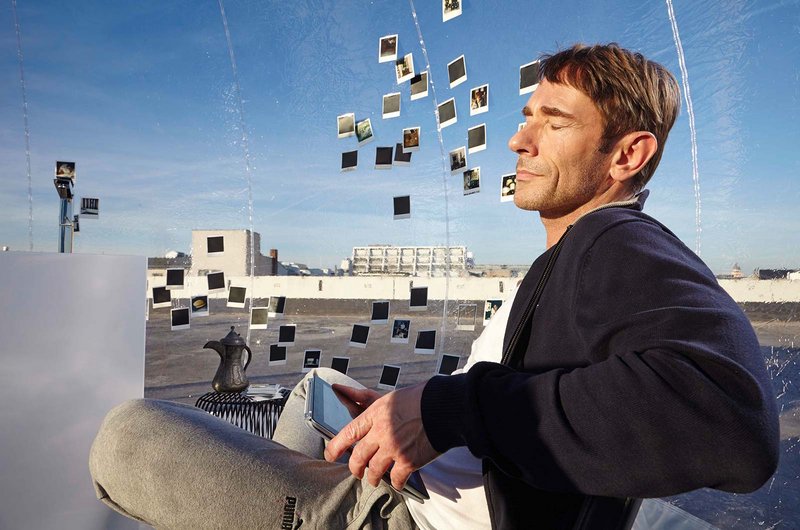
For many people, the bathroom seems like the final place of retreat in an everyday life dominated by a hectic pace and permanent availability, but also within their own four walls, which are becoming increasingly permeable to the outside world. With Bath- room Bubble, the bathroom is declared a protected area.
In the Bathroom Bubble, we can be alone and celebrate being alone.
As in every highly developed culture where increasing individualisation is being accompanied by dwindling privacy, we are increasingly drawing a distinction between our public persona and our private self. In the Bathroom Bubble, we can be alone and celebrate being alone. But it isn't just the seclusion of the bathroom that allows us to drop the mask. Coming into contact with water, one of the four classical elements, has a ritual function as well: it "washes away" our make-up, shell and armour and allows us to emerge from the shower or bathtub naked and feeling reborn. The bathroom thus becomes a place of encounter with the self, a cause for self-reflection and – when used to prepare for the outside world – a place of self-definition. For the Bathroom Bubble isn't just where we take things off, it's where we put things on as well – where we don a new mask, style our appearance and brace our inner selves.
The needs that are satisfied by this particular bathroom function are determined by the opposite of our everyday experiences. Whilst everyday life is governed by a hectic pace and the pressure to respond to external influences, satisfy expectations and adapt to external conditions, the inner sanctum of the Bathroom Bubble is governed by a sense of calm and its own laws. All the noises from outside are absorbed or eclipsed by noises that we cause ourselves, by our own thoughts and – in contrast to the constant stream of music from e.g. the radio – by music that is played for a specific reason. Here, everything is geared to the needs of the individual. Those who need order to feel comfortable keep things orderly, those who are forced to keep order in their everyday lives although they don't like it create disorder. This is where it's okay to forget the time, lose yourself in a book or your dreams and let your mind wander.
The Bathroom Bubble is also a place of creativity. It is no coincidence that many creative people say their best ideas come to them under the shower. And it's not just muscle tension that melts away in the bathtub, problems do too. The various dimensions shift, trivialities fade into the background and we get a clearer sense of what's important.
A bathroom cannot become a Bathroom Bubble unless it conveys a sense of security.
It's not so much a certain styling that is crucial for this positive effect as the creation of a separate – in future perhaps even soundproofed – protected environment ... and of emotionality. A bathroom cannot become a Bathroom Bubble unless it conveys a sense of security. And yet the factors that bring about this effect are of a thoroughly material nature: the specific atmosphere in which a person can feel at ease is defined by the product aesthetics, the product functions and the creative interplay between colours, materials and forms. Whilst a purist design might cater to the need to empty one's mind and distance oneself from the world, it is ultimately individual tastes that are the decisive factor. The design of a Bathroom Bubble is thus not dependent on any specific style. A Bathroom Bubble can be modern or antiquely opulent, organically natural or coolly angular, overloaded with ornamentation or floral elements or painstakingly purist.
The possibilities for a cosily furnished bathroom that the industry and designers have created in recent years are just as much responsible for the spread of the Bathroom Bubble as the inroads technology has made into what was once a lovelessly tiled room. Even today, digital features such as hands-free fittings, individualisable shower programmes and integrated lighting for the ceramic fixtures, mirror, tub, fittings and cabinets – or even the jet of water – are already endowing the bathroom with an incredibly high degree of cosiness, comfort and convenience. In the not too distant future, the bathroom will also be equipped with multimedia functions and the usual communication media. But even though they might enhance the quality of the space, these features are nevertheless ambivalent in the context of the Bathroom Bubble, for they divest it of its retreat function to some extent. And yet what some may find disruptive only increases the bathroom's value as a "different world" for others. Those who are into purism will manage without the additional features or switch them off, whilst those who like entertainment will be more than happy to enhance their island of calm with an appropriate programme.
The dreams we indulge in or the thoughts of escape we harbour in the Bathroom Bubble are no less individual. Probably the only thing these places have in common is the desire for a mix of freedom (from everyday obligations) and security – sometimes embodied by nature, sometimes in the anonymity of big city life. In a word, the bathroom is being declared a protected area. Regardless of whether we choose to pitch our tent in a natural idyll or an urban setting.
Products

The enamelled shower floor panel Xetis makes the water disappear into the wall. Digital technology pursues a definite goal – more convenient showering.
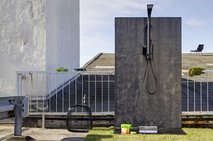
Supernova is a fitting with a highly sculptural quality; its numerous facets and polygonal surfaces are evocative of a crystal.
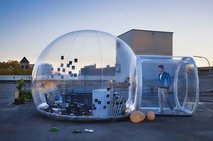
Be yourself! A multitude of individual configurations can be created by adding different basin and furniture models.
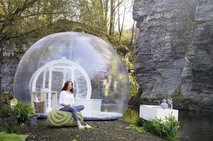
Urinals are a male preserve and a "must have" in the urban bathroom – preferably in a separate area.

A deep, oval basic form, an innovative bath fitting, two identical sloping ends and a central drain: a particu- larly enjoyable and comfortable way to take a bath together.
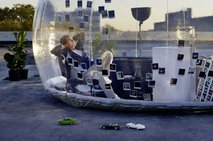
Facing the truth: illuminated Bella Vista vanity mirror with 3x magnification.